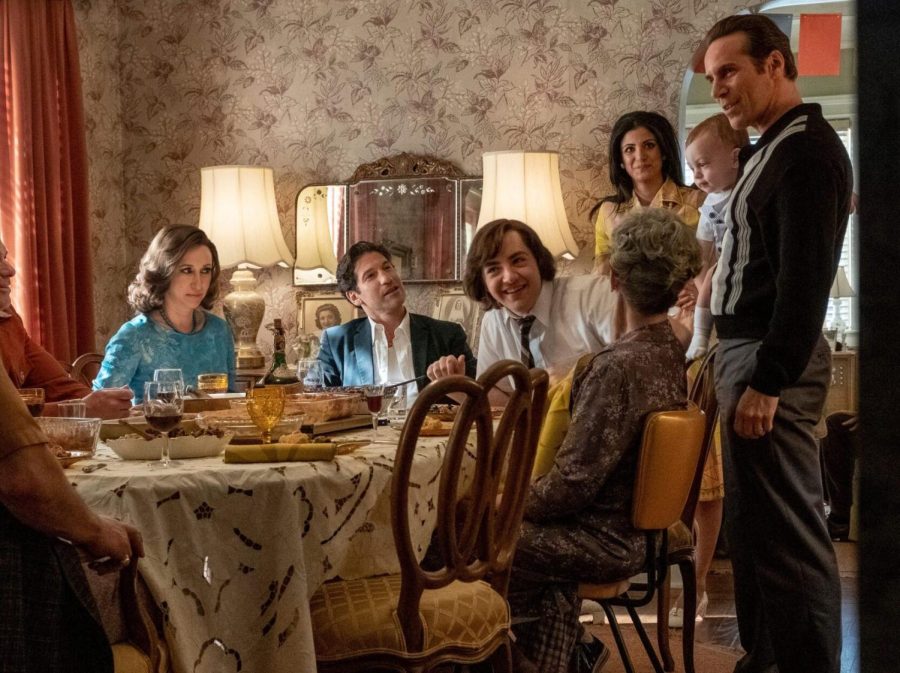Movie Review: The Many Saints of Newark
Courtesy of Warner Bros. Entertainments Inc.
A scene from the show “The Many Saints of Newark.”
September 29, 2021
The makers of “The Many Saints of Newark” had a very difficult, if not impossible, task; it had to measure up to one of the greatest television shows of all time: “The Sopranos.” The film, a prequel set about thirty years before the classic HBO show, had to make the Sopranos universe work within the medium of film, with a cast that could replicate the nuances of the show’s characters. And, for the most part, “The Many Saints of Newark” did the job.
“The Many Saints of Newark” is set in the late 1960s and early 1970s. It follows mobster Dickie Moltisanti as he and his crew engage in a violent gang war with an African-American gang, amongst other troubles.
The film premiered in New York City and in Europe on Wednesday, September 22. In the United States, the film is slated for release both in theaters nationwide and on HBO Max for one month beginning on Friday, October 1.
“The Sopranos” creator David Chase, who also produced and co-wrote “The Many Saints of Newark,” expressed to Deadline his disappointment over this HBO Max release, saying, “People should go see it in a theater. It was designed to be a movie. It’s beautiful as a movie. I never thought that it would be back on HBO. Never.” Chase’s reaction to the HBO Max release comes on the heels of a general backlash against films continuing to get virtual releases alongside theatrical ones. Most notably, Scarlett Johansson recently sued Disney for releasing the film “Black Widow” on Disney+ while it was still in theaters.
“The Many Saints of Newark” is getting significant attention for its casting choices. The late James Gandolfini starred as Tony Soprano in “The Sopranos,” and now his son Michael Gandolfini has a lead role in the film as young Tony Soprano. At first, this casting choice felt like a gimmick. However, the younger Gandolfini truly delivered. The immense talent of James Gandolfini really did trickle down to his son. Vera Farmiga’s performance as Tony’s mother, Livia Soprano, is perhaps the most impressive of all in the film. Farmiga effortlessly embodies Livia in every way, which is noticeable to any “Sopranos” fan. Most importantly, Alessandro Nivola’s performance as Dickie Moltisanti, the main character of the film, is executed successfully. Nivola never shows too much emotion, but manages to avoid being flat.
Some performances are not quite as impressive. Despite his physical resemblance to the character, actor Corey Stoll’s performance as Junior Soprano is not particularly convincing. Meanwhile, actor John Magaro’s performance as character Silvio Dante is too forced. It’s as if Magaro was doing a mediocre imitation of Silvio Dante, instead of actually embodying the attitude of a younger Silvio. Actor Jon Bernthal’s performance as Tony Soprano’s father, Johnny Boy Soprano, was also mediocre. This is especially disappointing, considering that Bernthal is usually a standout actor.
The feel of the film is totally different from the feel of the show, in both positive and negative ways. On the positive side, the cinematography is beautiful in a way that it never was in the show. The colors are vivid, the lighting is dramatic and the camera angles are creative. It’s easy to understand why Chase intended for this film to be viewed on the big screen. Also, the film does an excellent job of transporting you into the world of the 1960s and 1970s through its soundtrack, fashion and cultural references. The special effects are superb, as made particularly evident by the scenes depicting the chaotic 1967 Newark riots.
On the negative side, the film lacks the vitality that was present in the acting and the dialogue of “The Sopranos.” The actors do a great job, but they don’t converse as naturally with each other as did the actors in the show. This is excusable, though, largely because “The Sopranos” was a long-running series that had 86 hours to build chemistry. Viewers of “The Sopranos” knew the plotlines and character histories in-and-out, so conversations could get straight to the point. However, a two hour film, especially one with a large cast and a complicated plot, doesn’t have enough time to let actors reach this point. The dialogue must contain explanations in order to drive the film forward.
Occurring throughout the film is a race war of sorts, between black and Italian criminal gangs in a changing Newark. The war takes lives and drives the plot of the film, at least during the middle portion. However, (without spoiling any major plot points), this conflict is not wrapped up in any satisfying way; it just fades to the background. The film would have benefitted from giving more attention to this conflict toward the end, instead of leaving the viewer wanting more.
The film’s ending is sure to elicit a variety of reactions. The final sequence settles one of the biggest questions left unanswered by “The Sopranos.” It also refocuses the viewer’s attention toward Tony and his role in the New Jersey mafia world. In short, the ending was done very well. While David Chase will always have to deal with writing one of the worst television series finales with “The Sopranos,” Chase partially redeems himself by at least giving “The Many Saints of Newark” a proper ending.
All in all, “The Many Saints of Newark” is not a masterpiece. But it is a solid film. It also manages to be an entertaining watch for both loyal fans of “The Sopranos” and those who have never seen it. So, given the circumstances, this film was a success.



